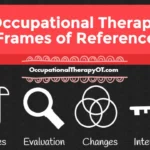Feeding
- The coordination of suck, swallow, breath for oral feeding begins at birth
- Infants are usually placed in a flexed position for feeding, held, or positioned with support and overtime, the infant gains head and neck control so they are able to feed in a seated position
- Fine motor and upper extremity control allows a baby to assist in holding a bottle and once their grasps and pincer grasp develop, this allows them to eat finger foods and use utensils independently

Chewing Pattern
- First- an up down munching pattern
- Tongue lateralization is the ability to move the tongue from side to side inside of the mouth. It’s an important skill for feeding therapy and development, as the tongue lateralizes in order to manipulate food to be chewed and formed into a ball (or bolus) before swallowing.
- Rotary jaw movement is a mature chewing motion, in which the jaw moves in a circular motion allowing for food to be grinded enough for swallowing. To promote this, a child can chew small pieces of food on the right side of the mouth and then switch to the left side of the mouth to promote the circular motion.
- Bite with front teeth by 12 months
- More difficult foods to chew by 24 months
- 2-3 years old, can add lots of table foods, with caution for high choking risk foods

Development of Feeding
- 10-14 weeks gestation: swallowing reflexes have been known to develop
- 16-20 weeks gestation: fetus mouths his or her thumb in early, non nutritive oral stimulation
- 15 to 18 weeks: sucking is observed however not until after birth is the infant able to coordinate suck, swallow, and breathing patterns for successful oral feeding.
- 0-3 months: full term healthy baby is ready to take on oral feeding by breast or bottle
- Early reflexes such as the rooting reflex, sucking reflex, and synchronized suck-swallow-breathe patterns typically aid in the infant’s success with initial oral feeding
- Infants use symmetrical oral motor sucking movements during this time
- When fed they are held by their caregiver in a flexed position- allows them to bring their hands to midline and eventually to the mouth
- Sensory input and social experiences during this time may become the foundation for parent-infant bonding and later social development
- 3-6 months: infant has developed improved head and neck control and is now able to lift and turn the head to maintain head position in supported sitting
- Often positioned more upright for feeding
- Oral reflexes are fading and the infant develops voluntary control over sucking and swallowing pattern
- Continues to use symmetrical oral motor movements to suck and extract liquid
- Increased mobility of the tongue is seen as infant explores toys and other items orally
- 6 months: continues to be fed by breast or bottle
- Infant is now ready for the introduction of spoon feeding with purees
- 8 months: ready for meltable finger foods
- 6-8 months: opens his or her mouth in response to the presentation of the spoon and with practice and experience learns to close mouth around the spoon to clear the puree in their mouth
- Chewing patterns: munching using symmetrical up and down movements characterized by the jaw and tongue moving together
- 8-12 months: infant begins to develop vertical chewing movements characterized by disassociation between the jaw and tongue.
-
- Tongue lateralization is emerging at this stage contributing to greater control of food within the oral cavity
- Cup drinking is introduced here
-
- 12-24 months: young toddlers are able to feed themselves independently because of further development and refinement of gross, fine, and oral motor skills
- Toddler uses mature pincer grasp and release pattern to pick up small finger foods and successfully place them in the mouth
- Cup drinking has progressed because breast/bottle feeding are fading
- Transition from high chair to less supportive chair- development of postural stability
- 12 months: toddler is able to bite though soft food with front teeth and has developed rotary chewing skills (diagonal jaw movement and presence of lateral tongue movements)
- Manage more challenging food textures: soft and coarsely chopped table food
- 18-24 months: mastery of spoon feeding
- Child learns to scoop with the spoon and orient the spoon correctly to feed with minimal spilling
- 24 months- 5 years: improved core stability and postural control- able to sit at the table without further adaptations or assistance.
- Independently self-feeding with fingers, utensils, and cups
- 2-3 year olds are eating a wide variety of table foods due further refinement of rotary jaw movement
- 5 years old- fully functional adult patterns have developed and intake in generally based on preference, exposure, and experience.

Swallowing Phases
Swallowing is a complex process during which saliva, liquids, and foods are transported from the mouth into the stomach while keeping the airway protected. Swallowing is commonly divided into the following four phases:
- Oral Preparatory—voluntary phase during which food or liquid is manipulated in the mouth to form a cohesive bolus—includes sucking liquids, manipulating soft boluses, and chewing solid food.
- Oral Transit—voluntary phase that begins with the posterior propulsion of the bolus by the tongue and ends with initiation of the pharyngeal swallow.
- Pharyngeal—begins with the initiation of a voluntary pharyngeal swallow which in turn propels the bolus through the pharynx via involuntary peristaltic contraction of the pharyngeal constrictors.
- Esophageal—involuntary phase during which the bolus is carried to the stomach through the process of esophageal peristalsis







